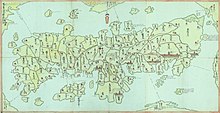Ōmura Domain
| Ōmura Domain 大村藩 | |
|---|---|
| Domain of Japan | |
| 1587–1871 | |
Mon of the Ōmura clan
| |
 Reconstructed yagura of Kushima Castle | |
| Capital | Kushima Castle |
| • Type | Daimyō |
| Historical era | Edo period |
• Established | 1587 |
• Disestablished | 1871 |
| Today part of | Nagasaki Prefecture |
Ōmura Domain (大村藩) was a Japanese domain of the Edo period. It is associated with Hizen Province in modern-day Saga Prefecture.[1]


History[edit]
The lineage of the Omura clan, who ruled over this region, has a somewhat obscure history. Still, they have held the position of lord since either the Heian or Kamakura period. Omura Sumitada, renowned as Japan's first Christian daimyo and believed to be the 12th head of the clan, sent his eldest son Kizen to aid Toyotomi Hideyoshi in the subjugation of Kyushu in 1587. As a result, he lost his territory in Kyushu Kokubun after the war. Kisaki, another member of the Omura clan, fought on the side of the Eastern Army in the Battle of Sekigahara.
Even after establishing the Edo shogunate, he was stripped of his primary territory and became the first lord of the domain. It is worth noting that the Omura Domain is exceptionally unique, as it managed to retain its territorial status from ancient times and was not subject to any transfers during the Meiji Restoration. Consequently, during the Edo period, the vassals were not organized, and there were many vassals in relation to the kokudaka. These vassals were not concentrated in the castle town, and even towards the end of the Edo period, approximately two-thirds of them resided in various villages rather than in Omura itself.
Yokoseura (Saikai City, Nagasaki Prefecture) was established by Sumitada in 1561, followed by the transfer of Nagasaki to the Portuguese in 1570. This marked the beginning of Nagasaki's development as Japan's primary hub for the Nanban trade. 2. By 1580, the vicinity surrounding Nagasaki Port was granted to the Society of Jesus as an ecclesiastical territory, further solidifying the city's ties to the Church. 3. However, the prosperity of Nagasaki as a trading center faced challenges when the Toyotomi government, the Edo shogunate, and, eventually, the central government took direct control over the region, resulting in a loss of trade profits for the city. Following the abolition of feudal domains and the establishment of prefectures in 1871, Omura Prefecture emerged as a new administrative division.
However, it was later incorporated into Nagasaki Prefecture, becoming a part of its jurisdiction. Notably, the Omura family's status underwent significant changes during this period. In 1884, they were elevated to the rank of viscount, and subsequently, in 1891, their accomplishments in overthrowing the Shogunate were acknowledged, leading to their promotion to the esteemed title of count.[2] [3]
List of daimyo[edit]
Name Tenure Courtesy title Court Rank kokudaka  Ōmura clan, 1587 - 1871 (fudai daimyo)
Ōmura clan, 1587 - 1871 (fudai daimyo)
1 Ōmura Yoshiaki (大村喜前)[4] 1587 – 1616 Tangō-no-kami Junior 5th Lower Grade (従五位下) 28,000 koku 2 Ōmura Sumiyori (大村純頼) 1616 – 1619 Minbu-daisuke Junior 5th Lower Grade (従五位下) 28,000 koku 3 Ōmura Suminobu (大村純信) 1620 – 1651 Tangō-no-kami Junior 5th Lower Grade (従五位下) 28,000 koku 4 Ōmura Suminaga (大村純長) 1651 – 1706 Inaba-no-kami Junior 5th Lower Grade (従五位下) 28,000 koku 5 Ōmura Sumimasa (大村純尹}) 1706–1712 Chikugo-no-kami Junior 5th Lower Grade (従五位下) 28,000 koku 6 Ōmura Sumitsune (大村純庸) 1712 – 1727 Ise-no-kami Junior 5th Lower Grade (従五位下) 28,000 koku 7 Ōmura Sumihisa (大村純富) 1727 – 1748 Kawachi-no-kami Junior 5th Lower Grade (従五位下) 28,000 koku 8 Ōmura Sumimori (大村純保) 1748 – 1761 Danjō-shōhitsu Junior 5th Lower Grade (従五位下) 28,000 koku 9 Ōmura Sumiyasu (大村純鎮) 1761 – 1803 Shinano-no-kami Junior 5th Lower Grade (従五位下) 28,000 koku 10 Ōmura Sumiyoshi (大村純昌) 1803 – 1836 Tangō-no-kami Junior 5th Lower Grade (従五位下) 28,000 koku 11 Ōmura Sumiaki (大村純顕) 1835. – 1847 Tangō-no-kami Junior 5th Lower Grade (従五位下) 28,000 koku 12 Ōmura Sumihiro (大村純熈)) 1847 – 1871 Tangō-no-kami Junior 5th Lower Grade (従五位下) 28,000 koku
See also[edit]
References[edit]

- ^ "Hizen Province" at JapaneseCastleExplorer.com; retrieved 2013-5-28.
- ^ Yoshiaki, Kusudo (2006) 戦国武将名言録. PHP Institute. ISBN 978-4569666518. (In Japanese)
- ^ Shinjinjin, Oraisha (1977).江戸三百藩 藩主総覧 歴代藩主でたどる藩政史.Bessatsu History Reader 24 Edo 300 Domains. ISBN 978-4404025241. (In Japanese)
- ^ a b Papinot, Jacques Edmond Joseph. (1906). Dictionnaire d'histoire et de géographie du Japon; Papinot, (2003). "Ōmura" at Nobiliare du Japon, p. 47; retrieved 2013-6-2.

